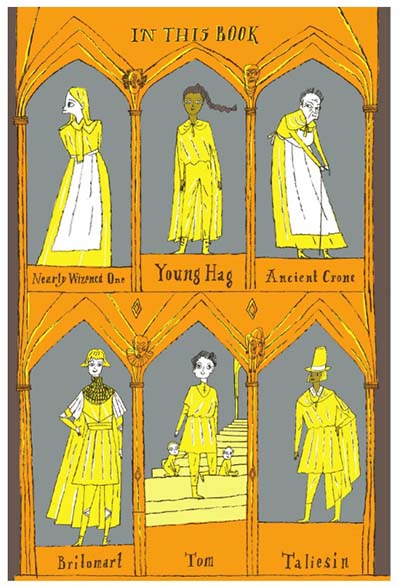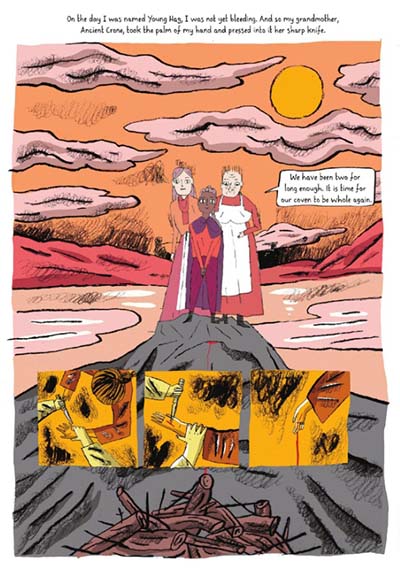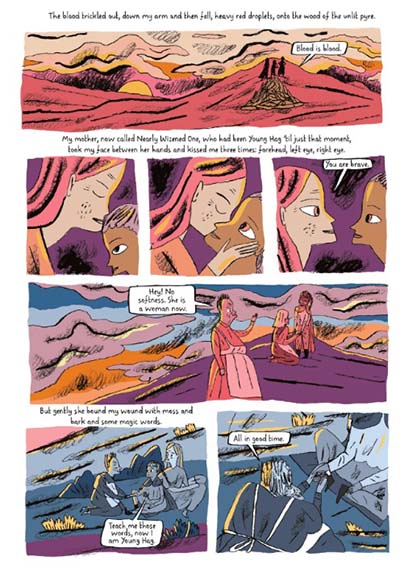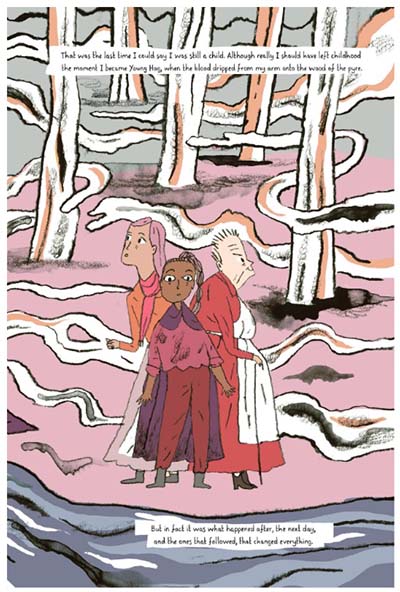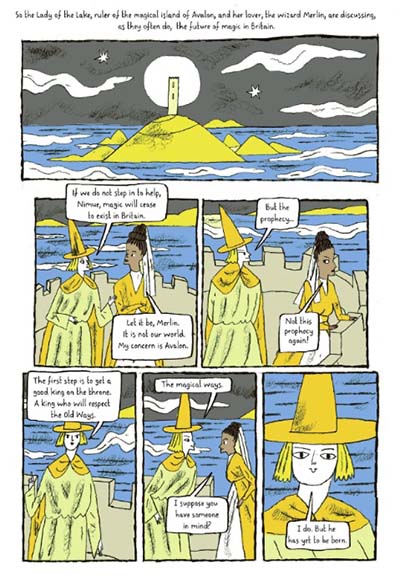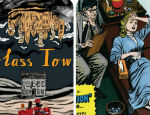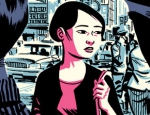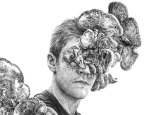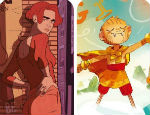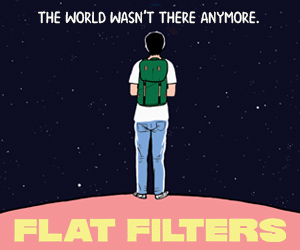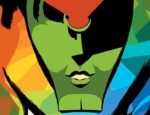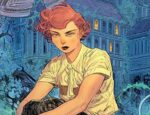‘Once there was magic in Britain. There were dragons and wizards and green knights and kings who pulled swords out of stones. But now, the doors to the Otherworld have closed’. So the blurb of Isabel Greenberg’s latest graphic novel Young Hag informs readers. Set in a world of witches, magic and quests, this coming-of-age story is marketed as a contemporary reinvention of the Arthurian legend, this time with women at the front and centre. With previous accolades in her repertoire such as The Encyclopaedia of Early Earth, The One Hundred Nights of Hero (a feminist retelling of The Arabian Nights), and Glass Town, based on the life and writings of the Brontë siblings, this is Greenberg’s first step into the imaginative world of Arthurian legend. Can Young Hag capture the same magic and warmth of Greenberg’s past projects? Let’s dive in and see!
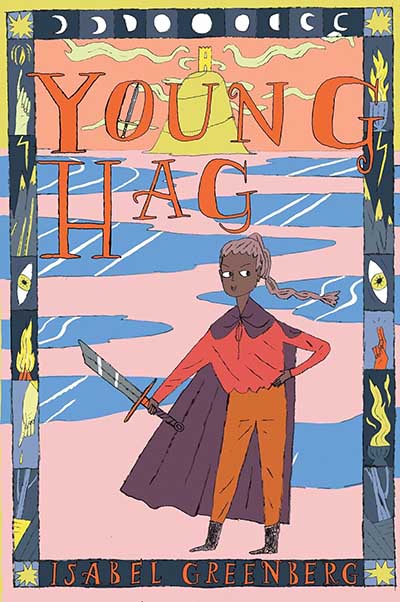
As a personal fan of Greenberg, both as an artist and graphic novelist, Young Hag had a lot to measure up to. The Encyclopaedia of Early Earth was my first introduction to the world of graphic novels and set a hugely high bar for the many, many (MANY!) graphic novels and comics I would read in the years to come. Reading a new Greenberg graphic novel is a rare and much-savoured treat, which I intended to thoroughly enjoy. I was pleased to see that, in typical Greenberg fashion, the cover of Young Hag was hugely detailed, showing our heroine front and centre, shimmering lakes surrounding her, and a castle on the mount at the precipice. Surrounding this backpiece in a rectangular border are various mosaics, depicting eyes, a full moon cycle, fire, mountains, and trees. Inside, readers are greeted with two detailed maps; one of Arthurian Britain and one of the ‘otherworld’, all beautifully sketched and coloured by Greenberg. In another Greenberg signature, we have character introductions before we even get into the story; most helpful for longer graphic novels like this one.
The story begins with a prologue, giving some context to the narrative to follow; the wizard Merlin is worried that magic will soon be lost from the land, and the gateway between our two worlds will close forever. However, his magic mirror tells him that someone will restore the balance – but it isn’t Merlin himself. It is, in fact, a woman (gasp!). Here our story begins: meet Young Hag, recently initiated into her family’s coven of witches. Despite having some powers, like brewing potions, these witches don’t have any real magic – magic has been eradicated from the land by the Lady of the Lake, after being betrayed by her apprentice. This twisted tale only becomes more convoluted from there, with her grandmother, Old Crone, revealing herself as King Arthur’s older sister Morgan; a controversial figure in Arthurian legend, Morgan is a powerful sorceress who, depending on the text, is either Arthur’s protector or his enemy. As her role in the past narrative slowly unrolls in the present, Young Hag must decide for herself where her destiny truly lies, as tragedy strikes and a gate between the two worlds appears to open.
Shifting between the tale of King Arthur and Merlin and the present-day adventure of Young Hag and her family keeps the story intriguing and mysterious, with the art style of Camelot being more traditionally illustrated in simple yellow hues, and the present-day storyline being vibrant and dramatic in tone. Slowly the reader is fed more titbits of exposition through Old Crone’s storytelling, until the bigger picture becomes clear. Classic tropes of a bildungsroman are apparent throughout, as we watch Young Hag through her formative years as she loses her faith in magic and goes on a spiritual journey.
As Young Hag had been marketed as a young adult graphic novel, I was concerned that it wouldn’t have the usual detailed storytelling that Greenberg so expertly weaves, but I needn’t have worried – the story is, as always, masterfully told. Having Young Hag at the centre of an Arthurian narrative subverts the classic trope of a male protagonist as the hero and allows a more childlike perspective to take the helm. Coupled with expert storytelling is the beautiful artwork that always makes Greenberg’s graphic novels stand out from the crowd. With stunningly detailed pencil illustrations, and use of background colour to indicate a shift in mood, this technicolour wonder could easily be pored over for hours at a time.
An aspect I particularly enjoyed was the detailed allusions that Greenberg scattered. Obviously, there were many references to Arthurian legends and to Camelot, and I hugely enjoyed the spin that Greenberg put on each of these classic characters, but there were also references to the more obscure; Christina Rossetti’s Goblin Market, with its reminiscent, chilling calls of ‘come buy, come buy’ and the deadly cost of eating the fruit; the arguing stone giants in an allusion to another thrilling adventure in The Hobbit; and the giant cat that serves as a brave knight’s trusty steed, who bears a striking resemblance to My Neighbour Totoro’s Cat-Bus. I’m sure there are many more references that I’ve missed but picking up each of them felt like discovering an extra hidden treat from the author.
Facets of the story, particularly the way Young Hag interacts with the new magical world that develops around her reminded me of Luke Pearson’s Hilda series, with the sheer child-like wonder that comes from discovering magic for yourself, and all the whimsical creatures that are discovered along the way. The ease with which Greenberg has entered the world of YA, as well as that of myth and legend is absolutely another string to her bow, and another five out of five stars for me! I wait with great trepidation and crossed fingers for a glimpse at her next project!
Isabel Greenberg (W/A) • Jonathan Cape, £20.00
Review by Lydia Turner





